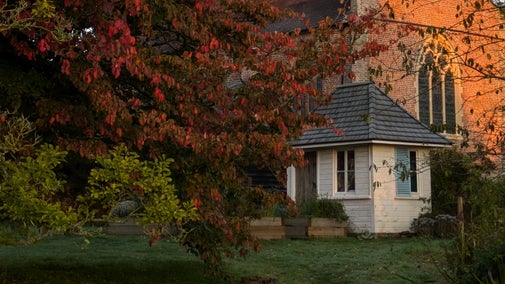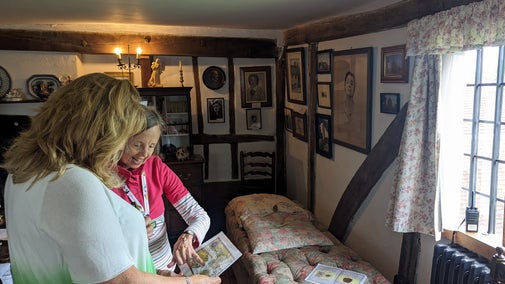
Discover more at Smallhythe Place
Find out when Smallhythe Place is open, how to get here, the things to see and do and more.

Before the decline of the port and shipyard at Smallhythe in the 16th century, the surrounding community was a key part of the shipbuilding workforce creating vessels for many significant figures including royalty. Learn about Smallhythe’s important shipbuilding families, the people that made the community and what existed before the port lost its workers.
Smallhythe, on the River Rother, was one of the most significant shipbuilding centres of medieval England from the 13th to the mid-16th century. Its decline came when the river began to silt up, leading to larger ships not being able to reach the area, and the collapse of the Knelle Dam upstream by the early 17th century.
Prior to Smallhythe’s decline as a port and shipyard in the 16th century, the area was thriving with activity. At the height of its success, Smallhythe was a community of around 200 people, most of whom were involved in shipbuilding.
The population would have increased by transient workers when large vessels were being built, and by sailors joining and leaving the ships.
The main settlement was centred on the road leading down to the riverbank and on Strand Syde, the road along the north bank of the river. Strand Syde was the area where most of the shipbuilding activity took place.
From here a ferry crossing to the Isle of Oxney provided an important link between the Cinque Port towns of Tenterden to the north and Rye and Winchelsea to the south.
In 1410, The Marie, a 100-ton vessel, was built at Smallhythe for Henry IV. Four years later, Henry V came to the shipyard to see two vessels that he had commissioned being built.
The Jesus was the first ship of 1,000 tons and The George, a balinger, of 120 tons. A balinger was a craft that could be rowed as well as sailed. In the 15th century they were used for scouting and raiding purposes.

During the 15th century, local society was dominated by several wealthy families involved in shipbuilding. One of the most successful and significant residents was Sir Robert Brigandyne.
He was clerk of ships to Henry VIII and supervised the design and construction of the Mary Rose. He lived and worked in the house now known as Priest's House, next to Smallhythe Place.
In 1545-6, Henry VIII ordered The Grand Mistress and The Great Gallyon to be built at Smallhythe. These were the last of the royal ships to be built at Smallhythe.
Toward the end of the 16th century, the community supported several inns and shops. There was a mercer's shop which provided a variety of goods including Holland cloth, saffron, prunes, sugar, aquavit (strong spirits), silk, white pepper, quicksilver, and gunpowder.
The shop was in a large timber-framed house and the proprietor, Henry Badcock, lived above the shop ‘in considerable comfort’. He had another equally well-stocked shop down river at Appledore.
Smallhythe’s decline in the 16th century as a prosperous port and shipyard made it difficult for ship workers to find employment.
After 1549, records of marriages, baptisms and deaths diminished in number, suggesting a fall in population, leading to an enquiry held to establish the need to retain the chapel at Smallhythe.
One witness said: ‘There is no haven there, saving only a creeke of salt water where no ship can come buy onely lyters and such kind of small vessels - and that only at full water.’

The tidal stream from the Rother flowed within a wider managed landscape of medieval harbours, crossing points, drainage channels and land reclamation along the border between Kent and Sussex.
The ‘landing place’ (or ‘hythe’) is recorded from the late 12th – early 13th century, and some of the great ships of the medieval and Tudor royal navy were built here during the 15th and 16th centuries. These included the Jesus, a thousand-ton vessel for Henry V, constructed in 1415 and Henry VIII’s Grand Mistress which set sail in 1545.
Hundreds of iron ship nails and roves – the distinctive diamond-shaped washers used to fix the boards of the vessels in place - have been found across the neighbourhood. In the Forstal Field, to the east of Smallhythe Place, ships’ timbers have been recovered, while across the road in the Elfwick Field, part of a late medieval kiln was excavated.
Where the port was in this part of Kent is now landlocked 12 miles from the coast, but is remembered for its busy days where royal ships were built for figures such as Henry VI and Henry VIII.
Today the waterway just to the south of Smallhythe Place, called the Reading Sewer, follows the old course of the River Rother for some miles and forms part of the complex drainage system of the Wittersham Levels.
Channel 4's Time Team visited Smallhythe Place in 1998 to carry out a number of surveys, including a study of aerial photographs and the opening of several exploratory trenches. A broken frame from a clinker-built vessel was found, as well as numerous iron fastenings and clench nails.
In 2023, the annual Dig was featured as part of the 2024 season of Digging for Britain which explored Smallhythe's medieval past.
Much of further the archaeological evidence at Smallhythe is subtle. Traces of the shipyard is just visible as earthworks in the fields to the east and west of Smallhythe Place.

Find out when Smallhythe Place is open, how to get here, the things to see and do and more.
Discover the history of Smallhythe Place, from a centre for royal ship building to the home of Ellen Terry, one of the most famous Shakespearean actors of the Victorian times.

Step into the Ellen Terry Museum at Smallhythe Place, a creative haven dedicated to the late Victorian actress, curated by her daughter Edy Craig.

Discover this charming cottage garden surrounding the house, with borders packed full of flowers, an orchard underplanted with bulbs and roses tumbling over the front of the house.

Discover what's on offer for families throughout our open season.

Join the volunteer team at Smallhythe Place working to preserve and share the story of actor Ellen Terry’s historic home.

Find out about the work we do in the winter months to maintain and conserve the museum, house, theatre and garden at Smallhythe, ready for the next season, including costume conservation.
